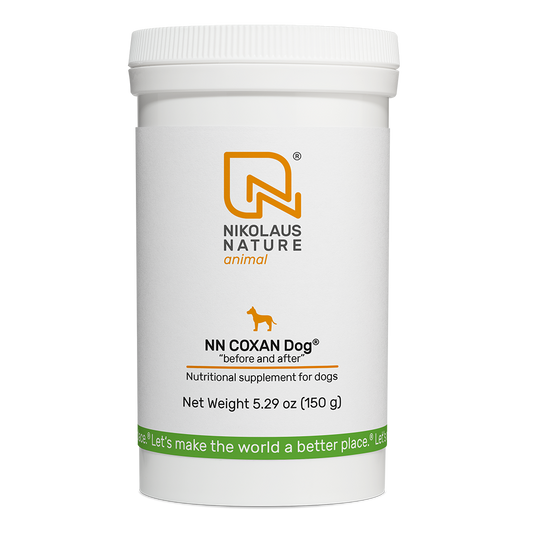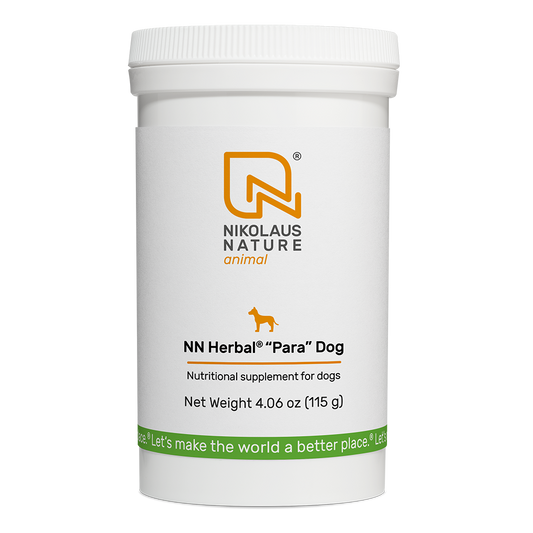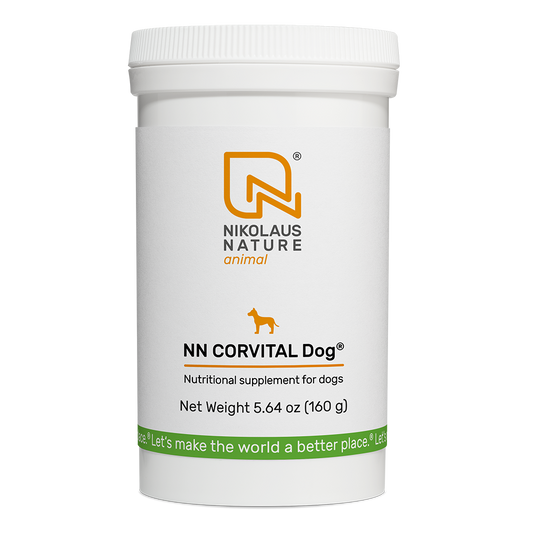Common heart problems for dogs
About one in ten dogs will be diagnosed with heart disease during their lifetime. However, this is not necessarily a death sentence. With appropriate medication and an adjusted lifestyle, the progression of the disease can be delayed, and the quality of life can be maintained. In this blog, you will learn everything about heart disease in dogs, including common issues and how to deal with them.

How a healthy dog’s heart works
A healthy dog's heart functions like a pump, consisting of two heart valves and the heart's conduction system. The heart is divided into four areas: two atria and two ventricles. Blood flow begins in the right atrium, where oxygen-depleted blood arrives. It is then carried to the lungs via the right ventricle to be re-oxygenated. From there, it passes through the left atrium into the left ventricle. The left ventricle pumps it back into the body with significant muscle power through the aorta. The heart beats continuously throughout life, so it is not surprising that increased signs of wear and tear occur, especially in older dogs.
Common heart diseases
In general, a distinction is made between diseases that affect the entire heart or muscles and those that affect the heart valves. Furthermore, one differentiates between congenital and acquired heart diseases. The majority of heart diseases in dogs is acquired with about 85%. These include:
-
Mitral endocardiosis (valve insufficiency):
This is the most common degenerative disease of the valve connective tissue. The valve no longer closes completely and blood backs up into the pulmonary circulation, which can lead to heart cough. -
Dilated cardiomyopathy (DCM):
The second most common disease is an enlargement of the heart muscle. The heart or parts of it are enlarged - with a concomitant decrease in performance. - In pericardial effusion, fluid collects in the pericardium.
- So-called cardiac neoplasms are either benign or malignant tumors of the heart.
In addition, there are congenital heart diseases:
- Subaortic stenosis is a narrowing below the aortic valve.
- Pulmonary stenosis is a malformation in the area of the so-called pocket valve.
- In ventricular septal defect, the dog is born with an opening in the septum between the left and right main chambers.
-
Persistent ductus arteriosus botalli (PDA):
The vascular connection between the aorta and the pulmonary artery, which normally closes on its own after birth, remains open. - Tricuspid dysplasia is a malformation of the valve between the right atrium and right ventricle.
In addition to known causes, there are also unknown triggers for canine heart disease. Metabolic, carcinogenic, toxic, infectious or genetic reasons may also be possible causes.

Cough as a symptom of heart disease
Cough is a concomitant symptom and can occur in many advanced heart diseases. It is usually caused by a weakening of the left heart muscle. A defective heart valve, weakness in the pumping of the left ventricle, or an enlarged left atrium can also trigger a heart cough. When blood is not adequately pumped into the body and remains in the heart, it becomes congested. The consequences are edema and fluid accumulation in the lungs. By coughing, the dog tries to get rid of the fluid.
Congenital vs. genetically inherited
Not all malformations and defects of the heart with which puppies are born are genetic. During gestation, environmental factors, toxins, malnutrition or malnutrition, medications, or maternal illness can cause the fetus to develop malformations. Only severe heart defects can be easily detected in puppyhood. In most congenital heart diseases, puppies develop inconspicuously and normally.
Breeds and their propensity to heart disease
Certain breeds are affected by hereditary heart disease more often than others. Therefore, heart screening is a must for responsible breeders. The first visit to the veterinarian is also a good opportunity to detect congenital defects. Immediate exclusion from breeding and prompt initiation of therapy are important. In puppies, a great urge to move in combination with a heart malformation or disease can even lead to sudden death.
Smaller dogs more likely to suffer valve regurgitation
On average, smaller dogs have a longer life expectancy than their larger counterparts, but when it comes to heart health, small dogs carry a greater risk. They have a higher incidence of valvular heart disease. Progressive age also increases the risk of developing valvular insufficiency. Breeds frequently affected are Yorkshire Terriers, Dachshunds, Miniature Poodles, and Miniature Schnauzers.
Larger dogs are prone to cardiomyopathy
Cardiomyopathy is common in large dogs and can occur even in young dogs. The most common symptom due to the thinner and weaker heart wall is cardiac arrhythmias. Sudden cardiac death is also not excluded in the case of untreated cardiomyopathy. Breeds more likely to be affected are Great Danes, Newfoundlands, Dobermans, Boxers, Saint Bernards, Cavalier King Charles Spaniels, Irish Wolfhounds, Rottweilers, German Shepherds, Leonbergers, Setters, Afghans, and large mixed breeds.
Recognizing heart problems and heart disease
Heart disease progresses insidiously and is often discovered at a late stage because it does not cause specific symptoms for a long time. This is because the dog's heart is able to compensate for the reduced capacity quite well for a long time. Dog owners are therefore often only confronted with the diagnosis when the heart failure is already advanced. With modern diagnostics, however, it can be detected very well. By means of an ECG, X-ray, and heart ultrasound, a reliable diagnosis can be made quickly. In any case, one should always pay attention to the following early signs and emergency symptoms in the dog:
General symptoms:
- Panting even with minor physical exertion
- Decreased exercise tolerance: slow movements and increased standing still
- Loss of appetite and weight
- Fatigue and exhaustion
- Nocturnal restlessness
- Apathy and stunted growth in puppies
Emergency symptoms for which a veterinarian must be consulted immediately:
- Blue discoloration of the mucous membranes in the mouth or tongue (cyanosis)
- Strained or pumping breathing with stretched neck
- Weakness and fainting spells
- Fluid accumulation in the lungs, abdomen, or legs
- Heart murmurs, soft heart sounds, or weak pulse
- Slow or fast heart rate and arrhythmia's

Therapy through appropriate medication
The first step should be the proper administration of medication. The daily heart tablet alleviates the strain on the heart and prevents symptoms of fatigue. This not only helps delay the progression of the disease but also significantly improves the dog's quality of life. ACE inhibitors and beta blockers are commonly used in drug therapy. They prevent blood pressure from rising, relieve the heart, or directly target heart receptors, allowing the dog to enjoy a longer period without symptoms.
Supportive lifestyle for a healthy heart
Heart disease and heart failure can understandably be shocking for any dog owner. Alongside drug therapy, owners can have a significant impact on the course of the disease by adopting a healthy lifestyle that includes appropriate exercise and dietary changes.
Exercise: moderation and purpose
Just because a dog has heart disease doesn't mean they have to spend their life confined to their bed. Exercise remains crucial for dogs with heart disease. However, walks should be shorter and more frequent. Extreme physical exertion must be avoided at all costs - it is important to keep the dog active without overtaxing or burdening them. On hot summer days, walks should take place during early morning or late evening hours as heat can strain the heart and circulation.
With a heart diet to more well-being
The second area that you can actively shape as a dog owner is the diet. A change in diet must be part of the therapy in any case, as it can have a strong impact on the dog's well-being and symptoms. Heart patients have some peculiarities as far as their nutritional needs are concerned. Therefore, the following points should be considered as part of a heart diet:
- High-quality, easily digestible protein and a high energy intake from foods with good biological value.
- Low sodium: If there is fluid accumulation in the body, low sodium feeding is important. As heart disease progresses, sodium cannot be properly excreted and accumulates in the body, which can adversely alter blood pressure.
- Addition of taurine: Taurine has been proven to support the heart functions of the dog, therefore an additional taurine as well as L-carnitine administration is very useful for the dog.
- Supplemental antioxidants: heart disease is accompanied by remodeling processes in the heart that produce free radicals. As a support, antioxidants can be used, which serve as radical scavengers.
- Increase potassium: Common cardiac medications cause long-term changes in electrolyte balance. This affects potassium, which is important for stimulus transmission in the body.
- Feeding in several small portions: Dividing the daily food ration relieves the strain on both the heart and the circulatory system, as they are not overly strained by digestion.
- Overweight should be avoided in any case, as too much weight has an unfavorable effect on the heart. Special care should be taken with additional snacks.
Although heart disease is not curable, it is still possible to create the optimal conditions for your four-legged friend's maximum quality of life through the right diet and exercise.
Taurine and its importance for heart health
Recent research has highlighted the crucial role of taurine in maintaining heart health. While dogs can produce taurine naturally, certain breeds, such as the American Cocker Spaniel, Newfoundland, and Golden Retriever, may be more prone to taurine deficiency. Clinical studies have identified taurine deficiency as a significant risk factor for heart disease.






